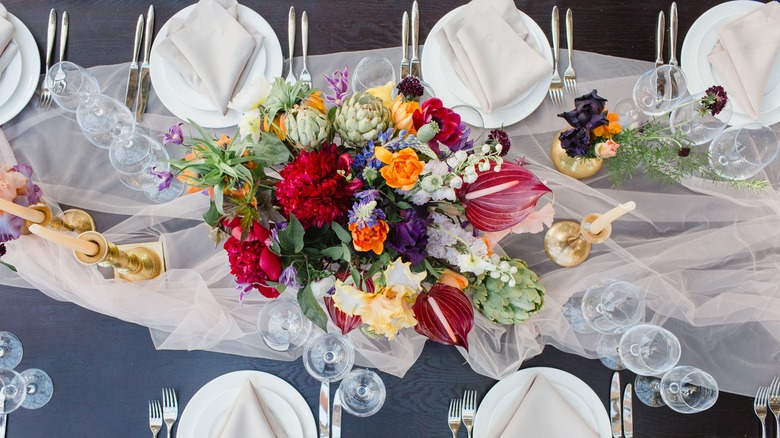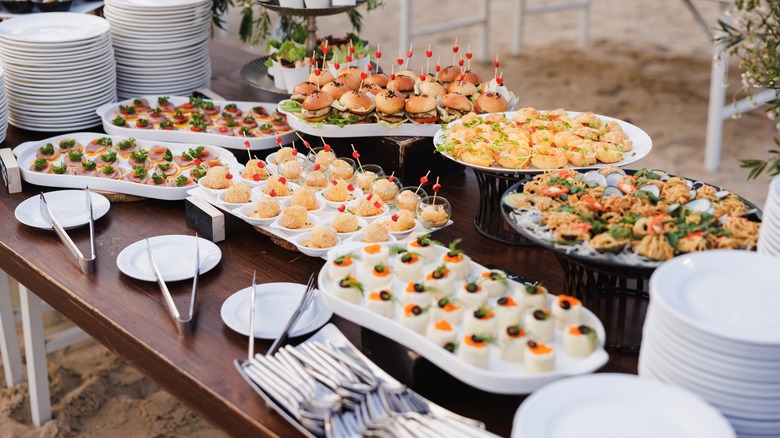11 Ina Garten Entertaining Rules You Shouldn't Break
Throwing a dinner party is an exciting occasion, giving you a chance to show off your culinary prowess while spending a lively evening with loved ones. However, it can also be a daunting task, and sometimes the pressure to be the perfect host can take some of the joy out of the occasion. One person who has mastered the art of hosting the perfect dinner party is the Barefoot Contessa herself, Ina Garten. The celebrated chef has hosted more than her fair share of soirees, and over the years, has shared her stories so that we mere mortals can learn from her experiences.
Renowned for her effortless elegance, Garten's philosophy on entertaining is focused on making hosting as easy and enjoyable as possible while still making sure your guests have a wonderful time. From carefully selecting your menu to being ruthless with your guest list, Garten has bestowed upon us many generous tips that allow us to follow confidently in her 'barefoot' steps.
Join us as we explore Garten's top rules for entertaining that will help you take control of your culinary event and feel confident that your guests will enjoy themselves. Whether it's your first time throwing a party or you're just looking to level up your game, her tips will infuse your party with the warmth and elegance that we have come to associate with Ina Garten.
Make dishes you can prepare in advance
One of the main factors in a successful dinner party, according to Ina Garten, is good preparation. By planning appropriately, you can take a lot of the stress out of the crucial few hours before the event and increase the chance that you'll actually enjoy yourself. Garten is certainly an advocate of preparing meals in advance — after all, she dedicated her entire book "Make It Ahead" to the concept!
Garten, though, has a unique trick to cutting down on the last-minute preparation for any gathering. She chooses a menu that includes four different preparation methods: one dish that can be made in advance, a low prep dish that can be popped in the oven and forgotten about it, a dish that will be cooked on the stovetop, and something that will get served at room temperature. That way none of them are competing for space or heat sources.
This genius tactical move means that your guests will be bowled over when you present four different dishes all at once, but you won't have to sweat it out in the kitchen to make it happen. Remember that, as host, your guests will pick up on your vibe, and this will set the tone for the evening. If they sense you are at ease due to your clever advanced preparation, they are likely to feel relaxed themselves and enjoy the evening.
Start with great flowers when setting the table
When you first start planning your dinner party, you may be wondering whether to use flowers as your centerpiece. The answer, according to Ina Garten, is a resounding yes. "When I'm setting the table for a dinner party, I start with the flowers and build from there," she says on her Instagram. "It's kind of like having the dress and then matching the jewelry and shoes."
While there are plenty of alternative centerpieces such as candles or fruit, flowers are classic. They have a way of brightening a room and making it feel welcoming. Of course, you can easily tailor them to fit your color scheme and decor as well.
If the thought of flower arranging worries you, Garten has a great tip. Stick to one type of flower, but choose it in a few different colors, as she likes to do with beautiful hydrangeas (via Instagram). This means you're not battling with different-sized flowers but you'll still get a pop of various colors with a uniform structure to them. If you are still not convinced about bouquets, Garten suggests using bud vases instead. These smaller vases can be strategically placed at various points on the table to add a floral touch without the need for flower arranging.
Set up a separate table for food
When it comes to entertaining, Ina Garten focuses heavily on having a natural flow to the evening and keeping things simple for yourself as the host. One of her top tips is to set up a separate table for the food, rather than placing everything on the dining table. On her Barefoot Contessa website, Garten explains, "When I have a dinner party I almost always set up a buffet on the counter or sideboard. Everyone can just help themselves — it's easiest for both the host and the guest!"
There are a number of reasons why a separate table makes the meal flow better. Firstly, it saves the awkwardness of people leaning over each other or passing heavy platters around. Family style is great for intimate gatherings, but the practicalities of your guests spooning food onto their plates from the middle of the table can be tricky. Secondly, since you won't be expecting anyone to lift the serving plates, you can serve courses in hot cookware, keeping the food warm for longer.
Removing serving bowls from the table frees up space for centerpieces, and gives guests a bit more elbow room; whereas a cramped dining table can lead to guests feeling uncomfortable and bumping each other as they eat and drink. Having a separate table will also bring a more relaxed feeling to the meal as guests make their way up and down from the food table, prompting conversation as they move around.
Let people serve their own drinks
Ina Garten's entertaining philosophy focuses on effortlessly keeping guests happy, and her approach to drinks is no different. "I find it's easiest to set up a self-service bar so everyone can mix their scotch and soda exactly the way they like it," says Garten on her website.
This simple but ingenious idea will take the pressure off of you as a host, and allow you to focus on the food instead of running around topping up everyone's glasses. It will also encourage your guests to mingle at the makeshift bar as they pour themselves a drink. Another benefit is that your guests will be able to pour their drinks to their own tastes, avoiding the issue of needing to remake them or switch to something else. This approach further encourages the idea that your guests are very welcome in your home and should treat it as their own. If they feel comfortable helping themselves to drinks, they will naturally feel more relaxed about the evening as a whole.
To set up your bar, simply designate a table with a variety of spirits, mixers, wines, beers, and non-alcoholic options. Don't forget essentials such as a wine bucket and bottle openers. If you have time, you could print off some cocktail recipes to encourage your guests to get creative!
Invite people round for Sunday lunch instead of Saturday night dinner
When planning a dinner party, most people would instinctively check with their potential guests to find a Saturday night when everyone is free. However, in an Instagram post, Ina Garten has a different suggestion. "My favorite time to entertain is actually Sunday lunch. Everyone's ... ready to relax and have some fun. Plus, the meal is so much easier to make than Saturday night!"
Sunday lunch has a different vibe to that of a Friday or Saturday night dinner. People will generally be more relaxed and laid back, potentially leading to less pressure on you as a host. If the weather plays along, you may even be able to host your event outdoors, should you wish. The food required for a Sunday lunch should also be easier to prepare than a more formal evening event. Think roast meat, vegetables, and potatoes that can all be prepared in the same pan, or a beautiful spread of antipasti, artisan bread, and a side salad. Your guests won't be expecting a three-course meal, meaning you can take it easy in the kitchen and spend more time relaxing.
An added bonus of a daytime gathering is the prospect of wrapping things up early. This might mean guests can walk home or take public transportation, rather than incurring the expense of a taxi cab, and everyone will have the rest of the evening free. This may be especially welcomed by those with young families.
Don't try to be too fancy
Ina Garten encourages us to keep dinner parties fairly casual, rather than going over the top trying to impress. In her book "Modern Comfort Food," Garten describes how attending a formal dinner party with crystal glasses and fine china can fill her with dread. "That kind of formality tends to make me more worried about knocking over a glass of red wine than connecting with other guests. Isn't that why we have dinner parties in the first place?"
This is an important reminder that the point of your event is to bring together loved ones and friends to bond and relax over great food and drinks. You can have an elegant affair without employing expensive flatware and dinnerware. Garten is an advocate for using whatever tools you already have at your disposal and says she often uses mismatched place settings or chairs. As long as your guests have a comfy chair to sit in and great company to share the food with, they won't be bothered about how fancy your place settings are. Focus on creating an inviting and warm space rather than trying to impress with elaborate decor.
This applies to the food, too. Prepare dishes that you know and love rather than pushing yourself to create something extravagant. By keeping the food and environment casual yet elegant, your guests will have a relaxed experience and leave feeling even better than when they arrived — which should always be your ultimate goal.
Keep it intimate
When planning your dinner party, you may feel under pressure to invite as many people as you can fit into your house, but there's no reason to think that bigger is better in this case. Ina Garten is a big believer that the best parties are the easiest ones to set up, and keeping the guest list short is a great way to take the pressure off. Four to six people is the perfect amount to stir up lively conversation. Garten recommends a round table for intimate dinner parties so that everyone can take part in the same discussion, but suggests a long table if you're throwing a much bigger soiree.
The chef also has a brilliant tip for keeping interesting conversation going. She advises seating the two most talkative people at opposite sides of the table in order to encourage the conversation to flow around them. If they sit beside each other, you may find they only talk to one another, and the rest of the table is left in awkward silence.
In her book "Parties," Garten suggests being very specific with instructions so there are no uncomfortable periods when you're waiting for guests who have misunderstood the invitation. If you want people to turn up at 6:30 p.m., make sure to tell them. By giving the vague instruction of 'any time after six,' you risk your party being left in limbo as you wait for stragglers.
Only use unscented candles
Candles are likely on your list of decorative accessories when preparing the room to create the perfect ambience. It may cross your mind to use scented candles; after all, a cinnamon-spiced candle at Christmas or rose and vanilla for summer is sure to add a delicious scent to complement the vibe of your party. However, Ina Garten warns against using scented candles anywhere that they could overpower the food. Stick with plain unscented candles instead, so there's no competition between food and candle aromas.
Garten's approach makes sense when you consider that the food should be the main focus of your dinner party. Strong aromas from candles or other air fresheners could be off-putting to your guests as they eat, and the scents may even spoil the flavor of the meal. Since flavor is actually the combination of scent and taste, your guests could end up tasting your lovingly prepared beef Wellington with a too-strong whiff of sweet lavender from the scented candle on the table. Not a good combo!
Instead, fill the house with the natural scents of baked bread and your sauces bubbling away on the stove, and stick to unscented candles on the table. You can always save your favorite scented candle for the bathroom!
Choose your guests wisely
In addition to deciding how many people to invite to your event, one important decision will be to choose exactly who gets an invitation. The dynamics of your affair will be hugely influenced by those sitting around the table, and Ina Garten has one very strict guideline when it comes to writing up the guest list. "I have very few rules for myself," she says, "but one of them is not to accept an invitation from someone unless I really want to invite him or her back." Her reason for this is simple: She only wants people at her parties that she truly wants to spend time with, and she does not want the awkward situation of not inviting people to her events when she has attended one of theirs.
You may feel uncomfortable missing out on friends-of-friends or people whose parties you have attended recently, but ultimately, you must be ruthless when making up your guest list. Only invite those you really want in your home.
Once you've narrowed down who you don't want there, you still have some decisions to make. You don't have to invite all of your friends to every single meal, especially if you plan on hosting multiple events. You'll likely want to invite people who have shared interests so that lively conversation can flow at the dinner table. Similarly, inviting a few people who are already acquainted will help break the ice and make everyone feel more comfortable.
Set up a great music playlist
In the excitement of preparing your meal and setting the dining table, it's important to remember the overall ambiance of the environment. As guests arrive at the event and start to mingle, it's essential to avoid the potential for awkward silence. Ina Garten suggests having music playing before your guests arrive to avoid this situation. "And, of course," says Garten on Instagram, "every great dinner party needs a special soundtrack!"
Garten has made this easy with her own personalized dinner party soundtracks, available on Spotify and Apple iTunes. They're full of classic artists from Louis Armstrong to Frank Sinatra and Barry White. If you prefer to create your own playlist, think of what music will set the tone for each section of your event. Take into account the wide range of ages of your guests, and try to include songs that will be familiar to each person.
Volume is important, as background music should be exactly that. Keep the volume low so that your guests can enjoy it at the same time as holding a conversation, especially during dinner. If you want to increase the volume later in the evening as the cocktails begin to flow, feel free to do so. The key is to judge the mood of the room and adjust the volume to suit. Just make sure there are no cameras around to catch your embarrassing dance moves!
Be sure to have fun
The final and arguably most important rule for the host from Ina Garten is a simple one — have fun! The simple act of throwing a party without having a meltdown is impressive enough. It may seem overly simple, but ultimately, what is the point of hosting a gathering if you are not able to relax and enjoy it alongside your guests? If you're overly stressed about the situation or obsessing that one of your dishes isn't perfect, you will take some fun out of the evening for both yourself and your guests who will pick up on your nervous energy.
The best way to have fun and remain relaxed is to follow in the footsteps of the Barefoot Contessa: Prepare as much of the food in advance as you can, don't invite too many guests, and let people serve themselves when appropriate, taking your role as waiter out of the equation. Garten also advises never making a dish for the first time when you have company — it puts too much pressure on even the most experienced of cooks.
In most cases, your guests will be close friends and family who will not be expecting you to get everything right. If something doesn't go to plan, tell them the truth, and you can all have a good laugh about it over a glass of wine. The whole point is to create precious memories and enjoy the moment.












